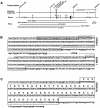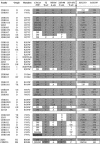CNGA3 mutations in hereditary cone photoreceptor disorders
- PMID: 11536077
- PMCID: PMC1226059
- DOI: 10.1086/323613
CNGA3 mutations in hereditary cone photoreceptor disorders
Abstract
We recently showed that mutations in the CNGA3 gene encoding the alpha-subunit of the cone photoreceptor cGMP-gated channel cause autosomal recessive complete achromatopsia linked to chromosome 2q11. We now report the results of a first comprehensive screening for CNGA3 mutations in a cohort of 258 additional independent families with hereditary cone photoreceptor disorders. CNGA3 mutations were detected not only in patients with the complete form of achromatopsia but also in incomplete achromats with residual cone photoreceptor function and (rarely) in patients with evidence for severe progressive cone dystrophy. In total, mutations were identified in 53 independent families comprising 38 new CNGA3 mutations, in addition to the 8 mutations reported elsewhere. Apparently, both mutant alleles were identified in 47 families, including 16 families with presumed homozygous mutations and 31 families with two heterozygous mutations. Single heterozygous mutations were identified in six additional families. The majority of all known CNGA3 mutations (39/46) are amino acid substitutions compared with only four stop-codon mutations, two 1-bp insertions and one 3-bp in-frame deletion. The missense mutations mostly affect amino acids conserved among the members of the cyclic nucleotide gated (CNG) channel family and cluster at the cytoplasmic face of transmembrane domains (TM) S1 and S2, in TM S4, and in the cGMP-binding domain. Several mutations were identified recurrently (e.g., R277C, R283W, R436W, and F547L). These four mutations account for 41.8% of all detected mutant CNGA3 alleles. Haplotype analysis suggests that the R436W and F547L mutant alleles have multiple origins, whereas we found evidence that the R283W alleles, which are particularly frequent among patients from Scandinavia and northern Italy, have a common origin.
Figures



Similar articles
-
Mutations in the CNGB3 gene encoding the beta-subunit of the cone photoreceptor cGMP-gated channel are responsible for achromatopsia (ACHM3) linked to chromosome 8q21.Hum Mol Genet. 2000 Sep 1;9(14):2107-16. doi: 10.1093/hmg/9.14.2107. Hum Mol Genet. 2000. PMID: 10958649
-
Cone cGMP-gated channel mutations and clinical findings in patients with achromatopsia, macular degeneration, and other hereditary cone diseases.Hum Mutat. 2005 Mar;25(3):248-58. doi: 10.1002/humu.20142. Hum Mutat. 2005. PMID: 15712225
-
Total colourblindness is caused by mutations in the gene encoding the alpha-subunit of the cone photoreceptor cGMP-gated cation channel.Nat Genet. 1998 Jul;19(3):257-9. doi: 10.1038/935. Nat Genet. 1998. PMID: 9662398
-
Comprehensive variant spectrum of the CNGA3 gene in patients affected by achromatopsia.Hum Mutat. 2022 Jul;43(7):832-858. doi: 10.1002/humu.24371. Epub 2022 Apr 14. Hum Mutat. 2022. PMID: 35332618 Review.
-
Cyclic nucleotide-gated ion channels.Physiol Rev. 2002 Jul;82(3):769-824. doi: 10.1152/physrev.00008.2002. Physiol Rev. 2002. PMID: 12087135 Review.
Cited by
-
Inherited macular degeneration-associated mutations in CNGB3 increase the ligand sensitivity and spontaneous open probability of cone cyclic nucleotide-gated channels.Front Physiol. 2015 Jun 9;6:177. doi: 10.3389/fphys.2015.00177. eCollection 2015. Front Physiol. 2015. PMID: 26106334 Free PMC article.
-
Genotypes and phenotypes of genes associated with achromatopsia: A reference for clinical genetic testing.Mol Vis. 2020 Aug 22;26:588-602. eCollection 2020. Mol Vis. 2020. PMID: 32913385 Free PMC article.
-
Endoplasmic reticulum stress-associated cone photoreceptor degeneration in cyclic nucleotide-gated channel deficiency.J Biol Chem. 2012 May 25;287(22):18018-29. doi: 10.1074/jbc.M112.342220. Epub 2012 Apr 9. J Biol Chem. 2012. PMID: 22493484 Free PMC article.
-
Gene Therapy for Achromatopsia.Int J Mol Sci. 2024 Sep 9;25(17):9739. doi: 10.3390/ijms25179739. Int J Mol Sci. 2024. PMID: 39273686 Free PMC article. Review.
-
Mapping of transcription start sites of human retina expressed genes.BMC Genomics. 2007 Feb 7;8:42. doi: 10.1186/1471-2164-8-42. BMC Genomics. 2007. PMID: 17286855 Free PMC article.
References
Electronic-Database Information
-
- GenBank, http://www.ncbi.nlm.nih.gov/ (for the CNG channel α-subunits of human cone photoreceptors [accession number AF065314], of mouse cone photoreceptors [accession number AJ243933], of chicken cone photoreceptors [accession number X89598], of human rod photoreceptors [accession number S42457], and of the bovine olfactory epithelium [accession number X55010], the Drosophila melanogaster CNG channel [accession number X89601], the Caenorhabditis elegans tax4 CNG channel [accession number D89601], and the CGNA3-covering BAC clones RP11-127K18 [accession number AC010134] and RP11-127K18 [accession number AC010134)
References
-
- Andreasson S, Tornqvist K (1991) Electroretinograms in patients with achromatopsia. Acta Ophthalmol 69:711–716 - PubMed
-
- Arbour NC, Zlotogora J, Knowlton RG, Merin S, Rosenmann A, Kanis AB, Rokhlina T, Stone EM, Sheffield VC (1997) Homozygosity mapping of achromatopsia to chromosome 2 using DNA pooling. Hum Mol Genet 6:689–694 - PubMed
-
- Ayyagari R, Kakuk LE, Coats CL, Bingham EL, Toda Y, Felius J, Sieving PA (1999) Bilateral macular atrophy in blue cone monochromacy (BCM) with loss of the locus control region (LCR) and part of the red pigment gene. Mol Vis 5:13 - PubMed
Publication types
MeSH terms
Substances
Associated data
- Actions
- Actions
- Actions
- Actions
- Actions
- Actions
- Actions
- Actions
- Actions
- Actions
- Actions
- Actions
- Actions
LinkOut - more resources
Full Text Sources
Other Literature Sources
Medical
Molecular Biology Databases

